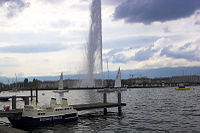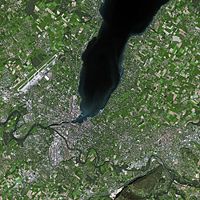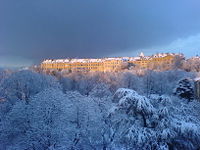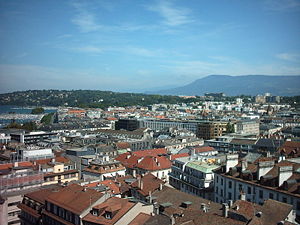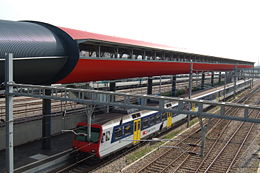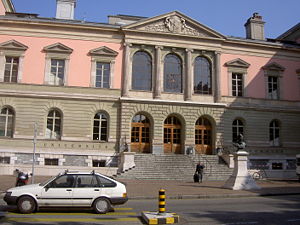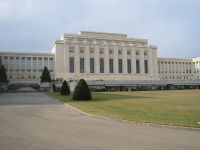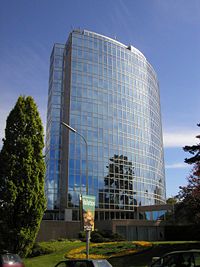Geneva
2008/9 Schools Wikipedia Selection. Related subjects: Europe; European Cities
| Genève | ||||||||||
|---|---|---|---|---|---|---|---|---|---|---|
|
||||||||||
| Population | 185,726 (2007) | |||||||||
| - Density | 11,710 /km² (30,330 /sq.mi.) | |||||||||
| Area | 15.86 km² (6.1 sq mi) | |||||||||
| Elevation | 375 m (1,230 ft) | |||||||||
| Geneva | ||||||||||
| Postal code | 1200 | |||||||||
| SFOS number | 6621 | |||||||||
| Mayor (list) | Patrice Mugny (as of 2008) Vert | |||||||||
| Demonym | Les Genevois | |||||||||
| Surrounded by (view map) |
Carouge, Chêne-Bougeries, Cologny, Lancy, Grand-Saconnex, Pregny-Chambésy, Vernier, Veyrier | |||||||||
| Website | ville-ge.ch | |||||||||
Geneva (French: Genève, German: Genf) is the second-most populous city in Switzerland (after Zürich) and is the most populous city of Romandy (the French-speaking part of Switzerland). Situated where the Rhône River exits Lake Geneva (French Lac Léman), it is the capital of the Republic and Canton of Geneva.
Geneva is widely regarded as a global city, mainly because of the presence of numerous international organizations, including the headquarters of many of the agencies of the United Nations and the Red Cross. It is also the place where the Geneva Conventions were signed, which chiefly concern the treatment of wartime non-combatants and prisoners of war.
A 2007 survey by Mercer Consulting found Geneva to have the second-highest quality of living in the world (narrowly outranked by Zürich).
Etymology
The word Geneva is of Celtic origin, and the city was later mentioned in Latin texts with the spelling Genava. It has been transformed by the speakers of other languages. Thus, it is Geneva in English and pronounced /dʒɨˈniːvə/, French: Genève IPA: [ʒənɛv], German: Genf ( help· info) [gɛnf], Italian: Ginevra [dʒiˈneːvra], and Romansh: Genevra.
History
Geneva (Genava of Geneva, also Janua and Genua), capital of the Swiss canton of the same name situated where the Rhône issues from the Lake of Geneva (Lacus Lemanus), first appears in history as a border town, fortified against the Celto-Germanic Helvetii, which the Romans took in 120 B.C. In A.D. 443 it was taken by Burgundy, and with the latter fell to the Franks in 534. In 888 the town was part of the new Kingdom of Burgundy, and with it was taken over in 1033 by the German Emperor. According to legendary accounts found in the works of Gregorio Leti ("Historia Genevrena", Amsterdam, 1686) and Besson ("Memoires pour l'histoire ecclésiastique des diocèses de Genève, Tantaise, Aoste et Maurienne", Nancy, 1739; new ed. Moutiers, 1871), Geneva was Christianised by Dionysius Areopagita and Paracodus, two of the seventy-two disciples, in the time of Domitian; Dionysius went thence to Paris and Paracodus became the first Bishop of Geneva but the legend is fictitious, as is that which makes St. Lazarus the first Bishop of Geneva, an error arising out of the similarity between the Latin names Genara (Geneva) and Genua (Genoa, in northern Italy). The so-called "Catalogue de St. Pierre", which names St. Diogenus (Diogenes) as the first Bishop of Geneva, is unreliable.
A letter of St. Eucherius to Salvius makes it almost certain that St. Isaac (c. 400) was the first bishop. In 440 St. Salonius appears as Bishop of Geneva; he was a son of St. Eucherius, to whom the latter dedicated his Instructiones'; he took part in the Councils of Orange (441), Vaison (442) and Arles (about 455), and is supposed to be the author of two small commentaries, In parabolas Salomonis and on Ecclesisastis (published in P. L., LII, 967 sqq., 993 sqq. as works of an otherwise unknown bishop, Salonius of Vienne). Little is known about the following Bishops Theoplastus (about 475), to whom St. Sidonius Apollinaris addressed a letter; Dormitianus (before 500), under whom the Burgundian Princess Sedeleuba, a sister of Queen Clotilde, had the remains of the martyr and St. Victor of Soleure transferred to Geneva, where she built a basilica in his honour; St. Maximus (about 512-41), a friend of Avitus, Archbishop of Vienne and Cyprian of Toulon, with whom he was in correspondence (Wawra in "Tubinger Theolog. Quartalschrift", LXXXV, 1905, 576-594). Bishop Pappulus sent the priest Thoribiusas his substitute to the Synod of Orléans (541). Bishop Salonius II is only known from the signatures of the Synods of Lyons (570) and Paris (573) and Bishop Cariatto, installed by King Guntram in 584, was present at the two Synods of Valence and Macon in 585.
From the beginning the bishopric of Geneva was a suffragan of the archbishopric of Vienne. The bishops of Geneva had the status of prince of the Holy Roman Empire since 1154, but had to maintain a long struggle for their independence against the guardians (advocati) of the see, the counts of Geneva and later the counts of the House of Savoy. In 1290 the latter obtained the right of installing the vice-dominus of the diocese, the title of Vidame of Geneva was granted to the counts of the House of Candia under count François de Candie of Chambery-Le-Vieux a Chatellaine of the Savoy, this official exercised minor jurisdiction in the town in the bishop's. In 1387 Bishop Adhémar Fabry granted the town its great charter, the basis of its communal self-government, which every bishop on his accession was expected to confirm. When the line of the counts of Geneva became extinct in 1394, and the House of Savoy came into possession of their territory, assuming after 1416 the title of Duke, the new dynasty sought by every means to bring the city of Geneva under their power, particularly by elevating members of their own family to the episcopal see. The city protected itself by union with the Swiss Federation (Eidgenossenschaft), uniting itself in 1526 with Berne and Fribourg.
The Protestant Reformation plunged Geneva into new entanglements: while Bern favoured the introduction of the new teaching and demanded liberty of preaching for the Reformers Guillaume Farel and Antoine Froment, Catholic Fribourg renounced in 1511 its allegiance with Geneva. The Protestant leader John Calvin was based in Geneva from 1536 to his death in 1564 (though briefly exiled from Geneva from 1538 to 1541), and began systematically to preach his doctrine there. The city became a centre of Protestant activity, producing works such as the Genevan Psalter, though there was much controversy (which remains to this day) regarding the relationship between Calvin and the civil authorities. As early as 1532 the bishop had been obliged to leave his residence, never to return; in 1536 he fixed his see at Gex, in 1535 at Annecy. The Apostolic zeal and devotion of St. Francis de Sales, who was Bishop of Geneva from 1602 to 1621, restored to Catholicism a large part of the diocese.
Formerly the Diocese of Geneva extended well into Savoy, as far as Mont Cenis and the Great St. Bernard. Nyon, also often erroneously considered a separate diocese, belonged to Geneva. Under Charlemagne Tarantaise was detached from Geneva and became a separate diocese. Before the Reformation the bishops of Geneva ruled over 8 chapters, 423 parishes, 9 abbeys and 68 priories.
In 1802 the diocese was united with that of Chambéry. At the Congress of Vienna (1814-15) the territory of Geneva was extended to cover 15 Savoyard and 6 French parishes, with more than 16,000 Catholics; at the same time it was admitted to the Swiss Confederation. The Congress expressly provided -- and the same proviso was included in the Treaty of Turin ( 16 March 1816) -- that in these territories transferred to Geneva the Catholic religion was to be protected, and that no changes were to be made in existing conditions without agreement with the Holy See. Pius VII in 1819 united the city of Geneva and 20 parishes with the Diocese of Lausanne, while the rest of the ancient Diocese of Geneva (outside of Switzerland) was reconstituted, in 1822, as the French Diocese of Annecy. The Great Council of Geneva (cantonal council) afterwards ignored the responsibilities thus undertaken; in imitation of Napoleon's "Organic Articles", it insisted upon the Placet, or previous approval of publication, for all papal documents. Catholic indignation ran high at the civil measures taken against Marilley, the parish priest of Geneva and later bishop of the see. Still greater indignation was aroused among the Catholics by the injustice created by the Kulturkampf, which obliged them to contribute to the budget of the Protestant Church and to that of the Old Catholic Church, while for their own religious needs they did not receive the smallest pecuniary aid from the public treasury. On 30 June 1907, most of the Catholics of Geneva voted for the separation of Church and State. By this act of separation they were assured at least a negative equality with the Protestants and Old Catholics. Since then the Canton of Geneva has given aid to no creed out of either the state or the municipal revenues. The Protestants have been favoured, for to them a lump compensation of 800,000 Swiss francs (about $160,000 then) was paid at the outset, whereas the Catholics, in spite of the international agreements assuring financial support to their religion -- either from the public funds or from other sources -- received nothing.
Geography
Geneva is located at 46°12' North, 6°09' East, at the south-western end of Lake Geneva, where the lake flows back into the Rhône River. It is surrounded by two mountain chains, the Alps and the Jura.
The city of Geneva has an area of 15.86 km² (6.1 sq mi), while the area of the Canton of Geneva is 282 km² (108.9 sq mi), including the two small enclaves of Céligny in Vaud. The part of the lake that is attached to Geneva has an area of 38 km² (14.7 sq mi) and is sometimes referred to as Petit lac (English: small lake). The Canton has only a 4.5 km (2.8 mi) long border with the rest of Switzerland; out of a total of 107.5 km (66.8 mi) of borders, the remaining 103 are shared with France, with the Départment de l'Ain to the North and the Département de la Haute-Savoie to the South.
The altitude of Geneva is 373.6 meters (1,225.7 ft), and corresponds to the altitude of the largest of the Pierres du Niton, two large rocks emerging from the lake which date from the last ice age. This rock was chosen by General Guillaume Henri Dufour as the reference point for all surveying in Switzerland. The second main river of Geneva is the Arve River which flows into the Rhône River just west of the city centre.
Climate
In Geneva, the winter is cold and generally a little cloudy. During the winter season, it is possible to go several days without thawing, and a day or two with severe frosts where the thermometer displays −10 °C (10 °F). There are several days each month when, if anticyclonic conditions are stable, the clouds may stay for several days. From March, with temperatures rising it feels like summer in late May. However, the rain intensifies and often has a stormy character during the month of May. These may be short but strong storms depositing tens of millimeters of rain within just a few minutes. Summers are often hot and rather humid, although, while some may be more changeable, the mornings remain relatively fresh. During the summer season, the rains are less frequent but more intense. This is the season which brings thunderstorms with hail. If the weather in early September is still hot, it cools down quickly to become really cold in November. The morning frosts then begin to reappear. Autumn is also the season of mists, and the month of October is often the one with the most fog in the year. This fog can be very intense, restricting vision to less than 100 meters (328 ft) in areas outside the city.
Cityscape
Culture
Traditions and customs
Geneva observes Jeune genevois on the first Thursday following the first Sunday in September. By local tradition, this commemorates the date the news of the St. Bartholomew's Day massacre of Huguenots reached Geneva. The Genevois joke that the federal equivalent holiday, Jeune fédéral, is observed two weeks later on account of the rest of the country being a bit slow on the uptake.
Since 1818, a particular chestnut tree has been used as the official "herald of the spring" in Geneva. The sautier (secretary of the Parliament of the Canton of Geneva) observes the tree and notes the day of arrival of the first bud. While this event has no practical impact, the sautier issues a formal press release and the local newspaper will usually mention the news.
As this is one of the world's oldest records of a plant's reaction to climatic conditions, researchers have been interested to note that the first bud appears earlier and earlier in the year. During the first century, many dates were in March or April. In recent years, it has usually been in mid-February and sometimes even earlier. In 2002, the first bud appeared unusually early, on 7th February, and then again on 29th of December of the same year. The following year, one of the hottest Europe has ever had, became a year with no bud. In 2008, the first bud also appeared very early, on 19 February.
Sports
The main sport team in Geneva is Servette FC, a football club founded in 1890 and named after a borough on the right bank of the Rhône. Servette was the only club to have remained in the top league in Switzerland since its creation in the 1930s; in 2005, however, management problems resulted in the bankruptcy of the club's parent company, causing the club to be demoted two divisions. It is now playing in second division.
Geneva is also home of the Genève-Servette Hockey Club, who play in the Swiss National League A. In 2008 the team made it to the league finals but lost to the ZSC Lions.
Administrative Divisions
The city of Geneva is divided into eight "quartiers" or districts, often made up of several conglomerated neighborhoods. On the Left Bank (Rive Gauche) these include Jonction, Centre / Plainpalais / Acacias, Eaux-Vives and Champel while the Right Bank includes Saint-Jean / Charmilles, Servette / Petit-Saconnex, Grottes / Saint-Gervais and Paquis / Nations.
Demographics
As of 2005, the population of the Commune (city) of Geneva was 185,028, while 441,000 people lived in the Canton of Geneva; around 960,000 people live in the Geneva urban community, which extends into Vaud Canton and neighboring France.
The population of the Canton is split between 148,500 people originally from Geneva (33.7%), 122,400 Swiss from other cantons (27.6%) and 170,500 foreigners (38.7%), from 180 different countries. Including people holding multiple citizenship, 54.4% of people living in Geneva hold a foreign passport.
While Geneva is usually considered a Protestant city, there are now more Roman Catholics (39.5%) than Protestants (17.4%) living in the Canton. 22% of the inhabitants claim not to be religious, the rest being shared between Islam (4.4%), Judaism (1.1%), other religions and people who did not respond.
Economy
Geneva's economy is mainly services oriented. The city has an important and old finance sector, which is specialized in private banking (managing assets of about 1 trillion USD) and financing of international trade. It is also an important centre of commodity trade.
Geneva hosts the international headquarters of companies like JT International (JTI), Mediterranean Shipping Company, Serono, SITA, Société Générale de Surveillance and STMicroelectronics. Many other multinational companies like Caterpillar, DuPont, Take Two Interactive, Electronic Arts, Hewlett-Packard, INVISTA, Procter & Gamble and Sun Microsystems have their European headquarters in the city too.
There is a long tradition of watchmaking ( Baume et Mercier, Chopard, Franck Muller, Patek Philippe, Rolex, Raymond Weil, Omega, etc.). Two major international producers of flavours and fragrances, Firmenich and Givaudan, have their headquarters and main production facilities in Geneva.
Many people also work in the numerous offices of international organizations located in Geneva (about 24,000 in 2001).
Geneva Motor Show is one of the most important international auto-shows. The show is held at Palexpo, a giant convention centre located next to the International Airport
Infrastructure
Transport
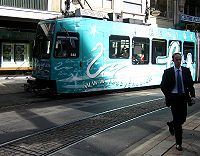
The city is served by the Geneva Cointrin International Airport. It is connected to both the Swiss railway network SBB-CFF-FFS, and the French SNCF network, including direct connections to Paris, Marseille and Montpellier by TGV. Geneva is also connected to the motorway systems of both Switzerland ( A1 motorway) and France.
Public transport by bus, trolleybus or tram is provided by Transports Publics Genevois (TPG). In addition to an extensive coverage of the city centre, the network covers most of the municipalities of the Canton, with a few lines extending into France. Public transport by boat is provided by the Mouettes Genevoises, which link the two banks of the lake within the city, and by the Compagnie Générale de Navigation sur le lac Léman (CGN) which serves more distant destinations such as Nyon, Yvoire, Thonon, Evian, Lausanne and Montreux using both modern diesel vessels and vintage paddle steamers.
Trains operated by SBB-CFF-FFS connect the airport to the main station of Cornavin in a mere six minutes, and carry on to towns such as Nyon, Lausanne, Fribourg, Montreux, Neuchâtel, Berne, Sion, Sierre, etc. Regional train services are being increasingly developed, towards Coppet and Bellegarde. At the city limits, two new stations have been created since 2002: Genève-Sécheron (close to the UN and the Botanical Gardens) and Lancy-Pont-Rouge.
In 2005, work started on the CEVA (Cornavin - Eaux-Vives - Annemasse) project, first planned in 1884, which will connect Cornavin with the Cantonal hospital, the Eaux-Vives station and Annemasse, in France. The link between the main station and the classification yard of La Praille already exists; from there, the line will go mostly underground to the Hospital and the Eaux-Vives, where it will link up to the existing line to France. Support for this project was obtained from all parties in the local parliament.
Taxis in Geneva can be difficult to find, and may need to be booked in advance especially in the early morning or at peak hours. In addition, which may be surprising in a modern country like Switzerland, taxis often refuse to take babies and children.
Utilities
Water, natural gas and electricity are provided to the municipalities of the Canton of Geneva by the state-owned Services Industriels de Genève (shortly SIG). Most of the drinkable water (80%) is extracted from the lake; the remaining 20% is provided by groundwater originally formed by infiltration from the Arve River. 30% of the Canton's electricity needs is locally produced, mainly by three hydroelectric dams on the Rhone River (Seujet, Verbois and Chancy-Pougny). In addition, 13% of the electricity produced in the Canton is made from the heat induced by the burning of waste at the waste incineration facility of Les Cheneviers. The remaining needs (57%) are covered by imports from other cantons in Switzerland or other European countries; SIG buys only electricity produced by renewable methods, and in particular does not use electricity produced using nuclear reactors or fossil fuels. Natural gas is available in the City of Geneva, as well as in about two-thirds of the municipalities of the canton, and is imported from Western Europe by the Swiss company Gaznat. SIG also provides telecommunication facilities to carriers, service providers and large enterprises. From 2003 to 2005 "Voisin, voisine" a Fibre to the Home pilot project with a Triple play offering was launched to test the end-user market in the Charmilles district.
Education
Geneva is home to the University of Geneva, founded by John Calvin in 1559. Also, the oldest international school in the world is located in Geneva, the International School of Geneva, founded in 1924 along with the League of Nations. Webster University, an accredited American university also has a campus in Geneva.
The city is home to the Graduate Institute of International Studies, as well as the International School of Geneva and Institut International de Lancy (founded in 1903).
The Geneva School of Diplomacy and International Relations is a private university on the grounds of the Château de Penthes, an old manor with a park and view of Lac Leman.
The Canton of Geneva's public school system has écoles primaires (ages 4-12) and cycles d'orientation (ages 12-15). The obligation to attend school ends at age 16, but secondary education is provided by collèges (ages 15-19), the oldest of which is the Collège Calvin, which is housed at the University of Geneva, and could be considered one of the oldest public schools in the world.
Geneva also has a choice of private schools.
Communities
As the Geneva authorities say, the history of the city is closely related to that of the foreign communities. Ever since the migration of foreigners to Geneva, these communities have found refuge, bringing their know-how, their customs and hope of a new life. They have widely participated in the international influence of Geneva, to its economic prosperity, and also to the spreading of views and of science.
LGBT community
Many other communities or minorities are also very well represented in Geneva, including sexual minorities, with no less than three organizations: Dialogai, a gay organization; Lestime, a lesbian organization; and association 360, an LGBT organization. The Gay International Group (Geneva, Switzerland) is a good resource for gay foreigners, tourists or expatriates. Also, a new LGBT group has debuted within the University of Geneva itself, called "Think Out". This group addresses students and professors linked directly or indirectly with the matter of sexual diversity.
Religious communities
Many religions are represented in Geneva. The Plymouth Brethren have an assembly there, established since the days of John Nelson Darby. The Catholic religion has become more influential, thanks to immigration from Latin countries. The Jewish community is one of the oldest of Switzerland. There have been two mosques in Geneva for more than 20 years.
International organizations
Geneva is the seat of the European headquarters of the United Nations and of many other inter-governmental organizations, including:
- The European Organization for Nuclear Research (CERN)
- The International Civil Defence Organization (ICDO)
- The International Labour Organization (ILO)
- The International Organization for Migration (IOM)
- The International Telecommunication Union (ITU)
- The Inter-Parliamentary Union (IPU)
- The United Nations High Commissioner for Human Rights (UNHCHR)
- The United Nations High Commissioner for Refugees (UNHCR)
- The United Nations Office for the Coordination of Humanitarian Affairs (OCHA)
- The World Health Organization (WHO)
- The World Intellectual Property Organization (WIPO)
- The World Meteorological Organization (WMO)
- The World Trade Organization (WTO)
- The European Broadcasting Union (EBU)
Geneva was the seat of the League of Nations between 1919 and the league's dissolution in 1946. It was first housed in the Palais Wilson, and then in the Palais des Nations, which now hosts the United Nations. Numerous international non-governmental organizations have also elected Geneva as their headquarters, including:
- The Aga Khan Foundation
- The Airports Council International
- The Conference of European Churches (CEC)
- The International AIDS Society
- The International Committee of the Red Cross (ICRC)
- The International Baccalaureate program
- The International Federation of Red Cross and Red Crescent Societies (IFRC)
- The International Organization for Standardization (ISO)
- The International Road Transport Union (IRU)
- The International Union Against Cancer (UICC)
- Mandat International (MI)
- The International Committee of Committees (ICC)
- The Programme for the Endorsement of Forest Certification schemes (PEFC)
- The UN Watch
- The World Business Council for Sustainable Development (WBCSD)
- The World Council of Churches (WCC)
- The World Heart Federation (WHF)
- The World Economic Forum (WEF)
- the World Organization of the Scout Movement
- The World Wide Web Virtual Library
- The International Association for the Study of Insurance Economics (also known as The Geneva Association)
- CARE International
- Youth With A Mission (YWAM)
- The international board of directors for Médecins Sans Frontières
The Geneva Environment Network (GEN) publishes the Geneva Green Guide, and extensive listing of Geneva-based global organizations working on environment protection and sustainable development. A website (by the Swiss Government, WBCSD, UNEP and IUCN) includes stories about how NGOs, business, government and the UN cooperate. By doing so, it attempts to explain why Geneva has been picked by so many NGOs and UN as their headquarter location.
Literature involving Geneva
- Belle du Seigneur by Albert Cohen, ISBN 2070404021
- Eleven Minutes by Paulo Coelho
- Frankenstein by Mary Shelley
- Politics and the Arts by Jean-Jacques Rousseau
- Angels and Demons by Dan Brown
- Daisy Miller by Henry James
- Comic books
- Asterix in Switzerland by René Goscinny and Albert Uderzo
- The Calculus Affair by Hergé
- Film and television
- The final part of Krzysztof Kieślowski's film trilogy, Three Colors called Three Colors: Red (1994), is set in Geneva
- The sequence The Ozerov Inheritance (1972) of the television series The Persuaders! is set in Geneva
- The protagonists of the television series The Champions were agents for a United Nations law enforcement organization called "Nemesis", which was based in Geneva.
- In 2005 Academy Award-winning Syriana (2005) Matt Damon plays an energy analyst based in Geneva.
- In the television series Babylon 5, the capital of the Earth Alliance is located in Geneva.
- The final scene of the movie F/X takes place in Geneva as the characters played by Bryan Brown and Brian Dennehy go there to recover a fortune from a bank.
- In the television series Mighty Morphin Power Rangers, the original Red, Yellow, and Black Rangers ( Jason, Trini, and Zack) were sent to a peace conference in Geneva when their actors left the show mid-season.
- Scenes from Sean Connery's James Bond Film Goldfinger (1964) are set in Geneva. While 007 supposedly lands in Geneva, and the map device in his car indicates that he is driving north along the left side of the city, the actual footage of the car moving along what should be Rue de Lausanne is not taken in or around Geneva, but rather further north-east in the German speaking part of the country.

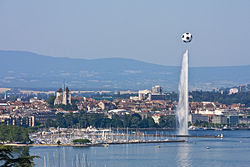
![Genève [zoom] (Switzerland)](../../images/601/60121.png)


